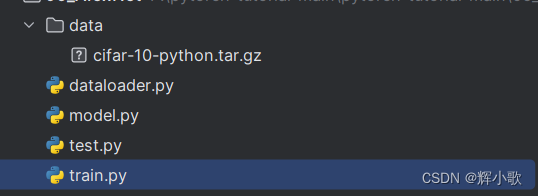PyTorch入门之【AlexNet】
参考文献:https://www.bilibili.com/video/BV1DP411C7Bw/?spm_id_from=333.999.0.0&vd_source=98d31d5c9db8c0021988f2c2c25a9620
AlexNet 是一个经典的卷积神经网络模型,用于图像分类任务。
目录
- 大纲
- dataloader
- model
- train
- test
大纲

各个文件的作用:
- data就是数据集
- dataloader.py就是数据集的加载以及实例初始化
- model.py就是AlexNet模块的定义
- train.py就是模型的训练
- test.py就是模型的测试
dataloader
import torch
import torchvision
import torchvision.transforms as transformsimport matplotlib.pyplot as plt
import numpy as np# define the dataloader
transform = transforms.Compose([transforms.Resize(224),transforms.ToTensor(),transforms.Normalize((0.5, 0.5, 0.5), (0.5, 0.5, 0.5))])batch_size = 16trainset = torchvision.datasets.CIFAR10(root='./data', train=True,download=True, transform=transform)
train_loader = torch.utils.data.DataLoader(trainset, batch_size=batch_size,shuffle=True)testset = torchvision.datasets.CIFAR10(root='./data', train=False,download=True, transform=transform)
test_loader = torch.utils.data.DataLoader(testset, batch_size=batch_size,shuffle=False)classes = ('plane', 'car', 'bird', 'cat','deer', 'dog', 'frog', 'horse', 'ship', 'truck')if __name__ == '__main__':# get some random training imagesdataiter = iter(train_loader)images, labels = next(dataiter)# print labelsprint(' '.join('%5s' % classes[labels[j]] for j in range(batch_size)))# show imagesimg_grid = torchvision.utils.make_grid(images)img_grid = img_grid / 2 + 0.5npimg = img_grid.numpy()plt.imshow(np.transpose(npimg, (1, 2, 0)))plt.show()
model
import torch.nn as nn
import torchclass AlexNet(nn.Module):def __init__(self, num_classes=10):super(AlexNet, self).__init__()self.conv_1 = nn.Sequential(nn.Conv2d(3, 96, kernel_size=11, stride=4, padding=2),nn.BatchNorm2d(96),nn.ReLU(),nn.MaxPool2d(kernel_size = 3, stride = 2))self.conv_2 = nn.Sequential(nn.Conv2d(96, 256, kernel_size=5, stride=1, padding=2),nn.BatchNorm2d(256),nn.ReLU(),nn.MaxPool2d(kernel_size = 3, stride = 2))self.conv_3 = nn.Sequential(nn.Conv2d(256, 384, kernel_size=3, stride=1, padding=1),nn.BatchNorm2d(384),nn.ReLU())self.conv_4 = nn.Sequential(nn.Conv2d(384, 384, kernel_size=3, stride=1, padding=1),nn.BatchNorm2d(384),nn.ReLU())self.conv_5 = nn.Sequential(nn.Conv2d(384, 256, kernel_size=3, stride=1, padding=1),nn.BatchNorm2d(256),nn.ReLU(),nn.MaxPool2d(kernel_size = 3, stride = 2))self.fc_1 = nn.Sequential(nn.Dropout(0.5),nn.Linear(9216, 4096),nn.ReLU())self.fc_2 = nn.Sequential(nn.Dropout(0.5),nn.Linear(4096, 4096),nn.ReLU())self.fc_3= nn.Sequential(nn.Linear(4096, num_classes))def forward(self, x):out = self.conv_1(x)out = self.conv_2(out)out = self.conv_3(out)out = self.conv_4(out)out = self.conv_5(out)out = out.reshape(out.size(0), -1)out = self.fc_1(out)out = self.fc_2(out)out = self.fc_3(out)return outif __name__ == '__main__':model = AlexNet()print(model)x = torch.randn(1, 3, 224, 224)y = model(x)print(y.size())
train
import torch
import torch.nn as nnfrom dataloader import train_loader, test_loader
from model import AlexNet# define the hyperparameters
device = torch.device('cuda' if torch.cuda.is_available() else 'cpu')
num_classes = 10
num_epochs = 20
learning_rate = 1e-3# load the model
model = AlexNet(num_classes).to(device)# loss and optimizer
criterion = nn.CrossEntropyLoss()
optimizer = torch.optim.Adam(model.parameters(), lr=learning_rate) # train the model
total_len = len(train_loader)for epoch in range(num_epochs):for i, (images, labels) in enumerate(train_loader):# move tensors to the configured deviceimages = images.to(device)labels = labels.to(device)# forward passoutputs = model(images)loss = criterion(outputs, labels)# backward and optimizeoptimizer.zero_grad()loss.backward()optimizer.step()if (i+1) % 100 == 0:print('Epoch [{}/{}], Step [{}/{}], Loss: {:.4f}'.format(epoch+1, num_epochs, i+1, total_len, loss.item()))# Validationwith torch.no_grad():model.eval()correct = 0total = 0for images, labels in test_loader:images = images.to(device)labels = labels.to(device)outputs = model(images)_, predicted = torch.max(outputs.data, 1)total += labels.size(0)correct += (predicted == labels).sum().item()model.train()print('Accuracy of the network on the {} validation images: {} %'.format(10000, 100 * correct / total))# save the model checkpoint
torch.save(model.state_dict(), 'alexnet.pth')
test
import torchfrom dataloader import test_loader, classes
from model import AlexNet# load the pretrained model
device = 'cuda' if torch.cuda.is_available() else 'cpu'
model = AlexNet().to(device)
model.load_state_dict(torch.load('alexnet.pth', map_location=device))# test the pretrained model on CIFAR-10 test data
with torch.no_grad():model.eval()correct = 0total = 0for images, labels in test_loader:images = images.to(device)labels = labels.to(device)outputs = model(images)_, predicted = torch.max(outputs.data, 1)total += labels.size(0)correct += (predicted == labels).sum().item()print('Accuracy of the network on the {} validation images: {} %'.format(10000, 100 * correct / total))
